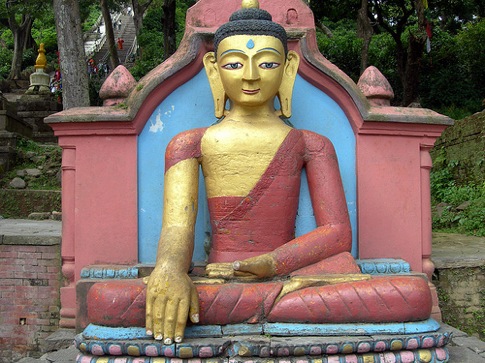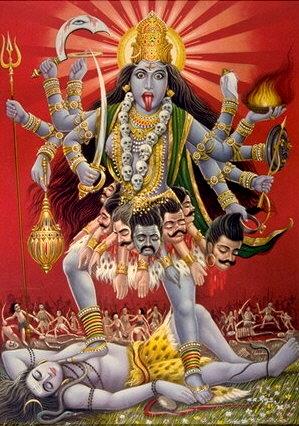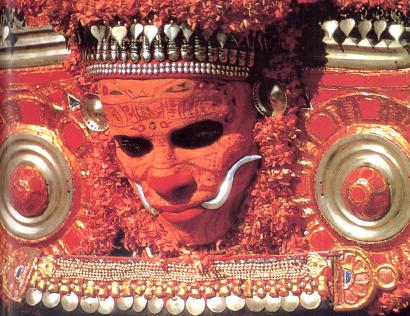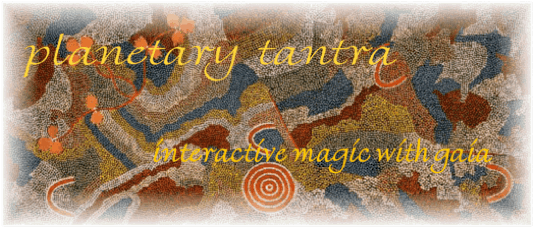| Site Guide |
| Tantra Tour |
| Gaian Tantra Vow |
| Foundations |
| SHAKTI CLUSTER | Dakini Calendar |
| Terma | Sierra de Libar |
The Tantric Conversion, I
From Sophia to the Shakti Cluster
After the publication of Not in His Image in November 2006, I received inquiries to this site, and inquiries from people I met here and there across the land, all posing the same question: Where do we go next?
For me, that book marked the completion of a life mission undertaken at the age of seventeen (as explained in the Foreword). It was a huge relief to complete this mission. You can well imagine that I was also asking myself where to go next. Truth be told, I made a pretty stretch down the road, pursuing my shamanic practices with Gaia (with and without the guidance of sacred plant allies), divining the skies, dancing to sarod music with Lydia—but I could not shake off that question. I felt an urgent responsibility to say something about how others might investigate and apply the Sophianic vision presented in my book.
My intentions in Not in His Image were threefold: deliver the samurai death blow to patriarchy, deconstruct the messiah, and restore the Sophianic vision story from the Mysteries, the mythic biography of the earth, including the scoop on those pesky Archons. This done, I scanned the horizon, uncertain of how to proceed. I was inclined to advise people: Go practice Gaia-oriented shamanism with sacred teacher-plants. But I sensed that this response was unsatisfactory.
Crackdown
I could not ignore the strong interest in entheogenic shamanism expressed by people who responded to my book. I had made a pretty good case for the role of sacred plants in the ancient Mysteries of Europa. Others are doing likewise these days, with some variations not to my liking or standards: for instance the revival of the Allegro thesis (Jesus was a mushroom), and the claim that Moses smoked weed, or ingested some other psychoactive plant (Benny Shannon), suggesting that patriarchal mind control scams like the Ten Commandments could have been received in a trance induced by sacred plants. I considered debating this (in my opinion) deranged notion and presenting a counter-argument: earth-alienating messages could not come from the instruction of the plant allies provided for us by Gaia herself, precisely so that our species can compensate for its Archontic tendencies (rejection of nature, religious other-worldliness, preference for simulation over the real). But the prospect of blogging endlessly on the Internet just did not appeal to me. A lot of blather in analogic ciphers, so little pleasure.
My first project upon finishing Not in His Image was the Paris Eadwine Psalter. Early in 2007, I considered doing a book on it. But circulation of a proposal with sample chapters and an outline produced no takers. So I dropped the book idea. Meanwhile, I added Psychonautics to the site, completing generation one, 1935 - 1965, then I left it hanging. A statement in that section of the site still resonates strongly for me:
Where an individual stands on the issue of access to psychoactive plants will determine, more than any other issue, how that individual engages in the coming planetary shift.
I stand by this statement. In the time since I wrote it, the paternal authorities have implemented a massive crackdown on psychoactive plants. In a major power-play launched from the Christian right, fresh magic mushrooms have been banned in Amsterdam. I was there in the "smart shop" of my friend Charles the day the new law came into effect. It has not yet been rigorously enforced, but its symbolic impact is more powerful than its legal implementation.
Conversations with Dominique Guillet of Kokopelli have convinced me that control of food is going to be decisive in the planetary crisis now upon us. The authorities are not merely intent to prohibit the use of psychoactive plants, they are also cracking down on time-tried natural remedies, such as stinging nettle. They are blocking the distribution of heritage seeds. If the frightening message of Esoteric Agenda is even partially true, there is a global program for massive population reduction via a double-whammy tactic of restricting food and poisoning the food chain. A UN document outlining this plan gives December, 2012 for the deadline when conditions for implementation of the grand scheme will be fully in place.
Reflecting on these matters, I realized that Gaian shamanism with psychoactive plants will rapidly become more and more difficult. Even without authoritarian control, such practice is not so easy for many people, especially those who live in cities. Psychoactive mushrooms and other natural entheogens may readily be purchased in large cities, but they cannot be used there for experimental nature mysticism. Other considerations as well impede such experimentation. Shamanic trance induced by natural entheogens such as ayahuasca and iboga has widely been co-opted for therapeutic rather than visionary aims; or it falls into the genre of shamanic tourism. The consistent, long-term community setting of the Gnostic cells would be difficult, if not impossible, to reproduce today. But without it, instruction by the Organic Light cannot be properly established and maintained.
Through 2007 and into 2008, I pondered long and hard on the future prospects for entheogenic shamanism, as it is now fashionably called. This practice will and must continue because sacred plants are essential to the course-correction of our species, and they aid enormously in the healing of both personal and social ills.
Entheogenic shamanism is problematic, and not suited for everone due to the rigors of the discipline and the need to shed egobound concerns about identity and social role-playing. I wondered what other kind of practice might be less problematic but equally pertinent in leading our species through the current crisis of social insanity and unsustainability?
Reduced to Kaka

Another question often came up after NIHI came out: How do we recover and revive Gnosticism? How do we recreate the Mysteries? My response to these questions was/is clear and definite: we don't. Gnosis is a timeless endowment of the human species: our capacity to perceive nature intensively (Goethe's method) and know the cosmos as the gods know it, in rapturous heightened awareness. Gnosis is cognitive ecstasy, knowledge that arises in a state of ecstatic beholding and selfless immersion in nature. This way of knowing is present, immediate, and inalienable, for it is rooted in the innate divinity of our species, the faculty of nous, divine intelligence. But "Gnosticism" is just the theological phantom of a dead movement. A revenant, not a living creature. I am completely bored by the revival of Gnosticism in sunday school sects with regalia and ritual, self-appointed priests and priestesses (Magdalene wannabes), liturgies, all the baggage and pretences that come with religiosity.
Brave readers, if you find anything that smacks of religiosity in my presentation of Kala Tantra, call me on it, please.
I dedicated twenty-five years of my life and studies to the sacred whore, but the romance of Mary Magdalene has precious little appeal for me any more... The Da Vinci Code ran that bodacious babe into the ground. Such a disgusting orgy of banal slander, crypto-fascist disinformation, and plain silliness. It's a sad day for Sophia when devotees who recognize her beauty and embrace her story cannot find a way to live cogently and passionately into the wisdom of the planet. Of course, many of you Sophia-lovers out there can and do just that, in your own way.
There is no single way to realize the Sophianic vision of the Mysteries. But as the sole person who restored and delivered that vision, I hold myself to a high standard for its application. Throughout this year, 2008, I pondered the future of entheogenic spirituality side by side with the obsolescence of Gnosticism. Over time, one realization hit me front and center: I could not advance in application of the Sophianic vision using Gnostic materials, even if I extrapolated them wildly. Why not? The basic problem with Gnostic studies is crappy syntax and inadequate vocabulary.
There are in my view no "original" Gnostic documents. I maintain that the Coptic writings from Nag Hammadi, and others found elsewhere and earlier, are no better than shambolic class notes hurriedly scribbled in the lecture hall. Coptic itself is a contrived language, invented to convert hieroglyphics at a time when almost no one could read them anymore. Every fourth or fifth word in Coptic is a loan from Greek. The grammar and syntax of Coptic is awkward. In NIHI, I compare it to hiking boots on a ballerina. Mud-caked hiking boots, I might say. Scholars admit that the NHC is riddled with inconsistencies, grammatical flukes and spelling errors, warped syntax, obscure pronomial referents. So much for the problems of the linguistic medium. The content of this mess of pottage is equally muddled and exasperating. A single text from Nag Hammadi can contain as many as six different viewpoints, mixing genuine Gnostic illuminism with Christian and anti-Christian elements.
Worst of all is the paltry vocabulary of the Gnostic materials. Evil was a huge issue in the Gnostic worldview. Gnostics arrogantly claimed that only they had the right explanation for evil, an assertion that drew brutal hatred from their Christian adversaries. The deans and teachers of the Mysteries refuted the Christian dualist view of evil, derived from the Persian dualism of Zoroaster. They carefully distinguished error from evil. They elaborated the scenario of the Archons, interpreting them as messengers of deception and simulation, not agents of evil who can control and overpower humanity. What is the Gnostic term for evil in Coptic? Kaka, borrowed from the Greek word meaning, literally, "shit." Put yourself in my place: I am eking out the Gnostic expose of the Archons, paraphrasing their brilliant theory of error, correcting the Christian idea of evil, and refuting Zoroastrian duality—quite an elaborate and sophisticated exercise, if I do say so—and all I have linguistically for building my argument is kaka.
The Gnostic theory of error is one of the most sophisticated creations of the human mind. If there's a better one, I'd like to see it. Yet I had to detect and develop that theory using so few terms: hal and sorem in Coptic, plané, anomou, and apathon in Greek. The challenge was spooky and often demoralizing. It left me convinced of the total inadequacy of surviving Gnostic materials to set up and support the Gnostic vision for today. I was lucky I got across what I did.
Sophia Amplified
Enough about the problem, let's cut to the solution. How did I steer the Gnostic Sophianic vision beyond the limits of Gnosticism in the direction that will now determine the principal content and future goals of metahistory.org? I did it in a New York minute, like this:
SOPHIA = WISDOM = VIDYA
Some readers may be familiar with the view of philologists (those who study languages), initially proposed by Sir William Jones, that Greek and Sanskrit have the same origin. This observation is the basis of a vast science, the study of Indo-European languages. Dictionaries use IE to designate the Indo-European root of a word. For instance, the IE root of "wisdom" is vid-. The v turns into w by what is called consonant shift, a linguistic phenomenon defined by the brothers Grimm around 1820. The two brothers who compiled "Grimm's Fairy Tales" were deeply involved in cross-cultural linguistic studies.
Excuse me for coming off academic, but consonantal shift is more than a tea-time topic for experts, or the passing fascination of a self-taught scholar such as I. Discovered at the key moment of the Romantic Movement, consonant shift proved to be a tool that transcended its specific use for philologists. With the study of IE roots underway, East and West converged with a spectacular, surf-like crash of affinities and parallels. In the introduction of Planetary Tantra, I said that I was going to show how Romanticism was seeded by Eastern mysticism, preparatory to the planetary shift today. Well, Greek-Sanskrit correlations contributed hugely to that epochal event of cross-fertilization.
The equation SOPHIA = VIDYA permits me to correlate Eastern and Western identities of the goddess embodied in the earth.
The Sanskrit root vid-, "wisdom, inspired or divine knowledge," generates the English word wisdom, but also wit. It is perhaps related to the Latin videre, "to see," which gives us video. (Sanskrit-Latin liaisons are a bit more dubious than Sanskrit-Greek.) It also appears to produce the word "guide". An on-line etymological dictionary says that guide is from Old French guider, first used textually in 1374, but is further traced to the Germanic root witan "show the way," from wit- "to know".
Vid- generates vidya, "production of vid." All scholars of Asian philosophy, Vedanta, the yoga sutras, Buddhism, etc., translate vidya as wisdom. But the Greek word sophia also means wisdom. The Online Etymological Dictionary says that sophia is from sophos, "of unknown origin." Sophia yields no direct linguistic resemblance to vidya, yet sophia and vidya both have exactly the same meaning.
Gnosticism was a vast spiritual movement in Europa, encompassing the Levant, Africa, and Europe. It spread eastward to the Hindu Kush, the region of the Pamirs where Alexander the Great pushed his campaign around 330 BCE. This meeting of East and West produced Gandarvan art, a synthesis of Greek and Buddhist styles. Under the reign of King Asoka (270-232 BC), the next century saw the extension of Buddhism into the west, right down into the Nile valley of Egypt. In his Edicts, the Asian sovereign declared: " The conquest by Dharma has been won here, on the borders, and even six hundred yojanas (5,400-9,600 km) away, where the Greek king Antiochos rules, beyond there where the four kings named Ptolemy, Antigonos, Magas and Alexander rule, likewise in the south among the Cholas, the Pandyas, and as far as Sri Lanka"(Edicts of Ashoka, Rock Edict 13).
East and West converged, Gnosticism and Buddhism merged. Way back then. Today, I propose a re-merge, using the formula SOPHIA = VIDYA.
Sophia was not merely a philosophical principle with her name embedded in the word, she was the wisdom goddess of the West, the supreme divinity of the Levantine Mysteries. Due to paltry vocabulary and poor construction, Gnostic texts offer little opportunity to amplify Sophia by correlations and extrapolations across the full range of her qualities, themes, and attributes. Classical images of Sophia, represented either as a cosmic deity or an earth goddess, are hard to find—Diana of Ephesus being one notable exception. Into the Middle Ages, images of Sophia tend to appear under the allegorical figure of Sapientia, Latin translation of the Greek Sophia. Little or nothing of the grandeur of the Gnostic vision of Sophia survives in these crude medieval caricatures. The Divine Sophia is, of course, the dominant figure in Greek Orthodox religion, but so deeply co-opted to the salvationist agenda and inflated Mariology of that faith that her tellurian qualities are lost.

The Fallen Goddess is a magnificent strange attractor, indeed, but isolated in the Gnostic Coptic material Sophia does not constellate a wide range of affinities and associations. The Greek-Sanskrit equivalence SOPHIA = VIDYA unlocks a realm of such affinities and associations, It is key that opens the door to the vast treasury of Asian goddess lore, including Hindu, Dravidian, Shaivite, Vishnaivite, Buddhist and Tibetan divinities.
To amplify Sophia, I go to Asian sources and re-merge Gnostic teachings with Indian and Buddhist Tantra. With SOPHIA = VIDYA, the Sophianic message of this site extrapolates in ways that I could not approach or even imagine while restricted to the Western Gnostic framework. I can now absorb and translate the rich legacy of Asian goddess lore into the visionary practice centered on Gaia-Sophia. This is the Tantric conversion.
The new orientation triggers a cascading series of correlations, a kind of fractal mirroring of the fluid identities of the goddess, beginning with Sophia-Sthavara and culminating in the fireworks of the Shakti Cluster. Let it be known to all who are attracted to this revelation, that I did not discover or contrive the Shakti Cluster by an exercise of mythological correlation, or mere word-play. I did not attain the interactive vision of the Gaian Shaktis by constructing linguistic parallels or shuffling the deck of Jungian correspondences. I was introduced directly to the Cluster in my shamanic practice. Over the course of the summer of 2008, I integrated this numinous vision and came to understand particular details and dynamics of the composite deities in the Cluster. I would describe it as a pyrotechnic display of the Divine Feminine, a visionary eruption in the aura of Gaia, the atmosphere. Living into this vision, I hit upon the SOPHIA = VIDYA formula and went to town with it.
So be assured, brave readers, that the Tantric conversion is not an academic game of name-swapping or an indulgent exercise in contrived parallels. Contemplate these cascading identities and you will enter the white water rapids of your own imagination. With this simple conversion, the Gaia-Sophia mystique goes interactive and sky-borne. Beyond talking about the Divine Feminine, this is how you get to talk to it.
In the last sentence of her book, Buddhist Goddesses of India, Miranda Shaw expresses the hope that, "in view of its extensive female pantheon, Buddhism may rightly take a place among the world's goddess religions." I noted in the introduction of Planetary Tantra that I will not be citing scholars or backing up my outrageous claims with textual quotes and statements from the experts. But I would crawl across Times Square at rush hour to kiss the feet of Miranda Shaw for the gift of this book, the follow-up to her equally magnificent offering, Passionate Enlightenment. Shaw is one of a small band of fearless woman scholars who are breaking Buddhism out of its patriarchal mold and liberating the goddess elements. She is more than a champion of the Divine Feminine, she is a divine feminist.
Buddhism as a goddess religion? How can this be? Well, Shaw opens with an argument that can hardly be refuted, if you ask me. She recounts the classic legend of the enlightenment of Shakyamuni, focusing on the theme of victory over Mara, the lord of illusion. Various biographies describe how the earth goddess, called Prithivi or Sthavara, intervened to dispel the illusions of Mara, leaving Shakyamuni in the perfect concentration required to attain enlightenment. Still, there came a moment of confrontation. Mara claimed that the Indian prince had nothing to show for his alleged superlative acts of generosity, not a single witness to attest that he, the man who would be a Buddha, had benefited humanity in any way. In other words, Mara accused Shakyamuni of being a narcissist, hung up in a self-centered quest for liberation.
Shakyamuni replied to this challenge by the words, "Let this great and solid earth be my witness," and by a movement of his hand, the bhumisparsa mudra, the gesture of touching the earth.

Miranda Shaw says that, because the "seat of enlightenment" is the earth itself, the earth goddess supports enlightenment. Through 519 pages she elaborates on a wide range of Asian earth goddesses who represent enlightened wisdom in ways that correlate to the Gnostic Sophia, without however once mentioning Sophia by name. This oversight does not mar the book. Rather, it clears the atmosphere and prepares reception for the Tantric conversion.
The earth-touching gesture of Shakyamuni at the moment of his enlightenment speaks volumes. Without the blessing of the earth, there is no foundation for Buddhahood. Without the acknowledgement of the feminine divinity of the earth, under whatever name, be it Prithivi or Sthavara or Sophia, no human being can receive or sustain full awakening to the nature of mind. The earth goddess, the mind of nature, enables realization of the nature of mind. The living presence of the earth goddess actually grounds that supreme realization. Even though the legend of the Buddhas appearing through time does not include a single human woman who attains enlightenment, Buddhism is the godchild of gynocentric mysticism, the favored offspring of Asian goddess religion.
Shaw's book invites and prepares recognition of Female Buddhas, Shaktis, Yoginis, Dakinis, and Dangerous Protectors that we will engage lavishly in Planetary Tantra. The earth-touching mudra guides the Tantric conversion.
The Ten Mahavidyas
Hindu religion, the matrix of historical Buddhism, presents a staggering array of god and goddesses. This is polytheism gone wild. A short list of female deities in the Hindu pantheon could easily run into hundreds. However, there is a single, outstanding constellation of female divinities that might be compared to the navel or belly-button of the human form. The navel is a unique point in the human torso, not a sense organ like an eye or ear, but the anatomical locus of vital force in the body. The solar plexus is the seat of prana, vitality. The navel is not only the anatomical feature that locates this plexus, it is also the point on the body that connects us to our birth. At the navel we were connected to the umbilical cord and the placenta. The navel pucker reminds us that we all emerged into this world from within the body of a woman.
This elaborated analogy fits the Shakti Cluster to a T. The Cluster is a unique locus of gathering power for the Divine Feminine. Scholars cannot explain why this ten female powers should be configured just as they are. Although there are a couple of origin stories for the Cluster, there is no explanation for its composition. The first reference to the Cluster occurs in the Shiva Purana. Purana means "from ancient sources." The Puranas are elaborate commentaries on the Vedas, often containing mythological tales. The earliest reference to the Shakti Cluster in the Puranas dates from around 500 BCE, the time of the historical Buddha, exactly at the midpoint of Kali Yuga.
According to the origin story in the Shiva Purana, a demon named Durgama gained control of the Vedas and caused a drought all over the earth. Here "the Vedas" signify not just the ancient religious texts that go by that name, but the primeval wisdom in those texts. Veda is of course derived from the root vid-. Since VIDYA = SOPHIA, we can say that the Vedas represent Sophianic truth, intimate knowledge of the earth and its intelligent, self-animating powers. The origin myth confirms this connection by stating that a planetary disaster, a drought, arose when that truth was jeopardized.
Now comes the wild part. All the male gods led by Brahma called upon the Goddess or Mahadevi to confront the demon, reclaim the Vedas, and save humanity from annihilation by drought. To do so, the Goddess emanated from her body the ten Mahavidyas, the Ten Great Wisdoms. Maha is the Sanskrit word for "great, supreme." All ten Mahavidyas are forms of the Goddess herself, but of these ten there is one who focalizes her fury: Kali. As the head deity of the group, Kali defeats Durgama and acquires the name Durga, "invincible," denoting her fierce warrior aspect. (Below: Typical image of Durga, the warrior goddess.)

So, the Mahavidyas consist of Kali and nine emanations of herself. In Yantra, Madhu Khanna introduces the term "Shakti-cluster" for the group of ten Mahavidyas. He cites a variant origin myth in another text, the Devibhagavata Purana, describing a quarrel between Shiva and his consort Parvati, in which Parvati transforms herself into the tenfold Kali. This myth does not refer to preserving the Vedas or saving the earth from a natural catastrophe; rather, it points to the consort yoga of the Shaivite cults of ancient India. A "quarrel" between Shiva and Parvati is a state of heightened energy generated by their mystic union ("consort yoga"). This myth suggests the advantage of engaging the Mahavidyas by pairing, working in couples—the Tantric buddy-system, if you will. I will describe the nature and necessity of consort yoga here and there throughout the forthcoming writings on Planetary Tantra.
The Instant
In August 2008 I initially understood the Shakti Cluster as it is described by Madhu Khanna and other scholars of Hindu religion, such as David Kinsley (Visions of the Divine Feminine). At the head of the group is Kali herself, who contains and emanates the other nine Mahavidyas. The usual order for the goddesses in the Cluster is:
Kali: power of eternal time in the instant, Kala
Tara: passage beyond time, deliverance
Shodashi: generation of beauty in time; also called Sundari
Bhuvaneshvari: fruition of time in sensory forms
Chinnamasta: awareness beyond self-bound sense of time
Bhairavi: annihilating tide of time
Dhumavati: closure of time, extinction
Bagala: illusion of time, the passing moment; also called Bagalamukti
Matangi: mastery of past and present, beyond temporal causality
Kamala: total beautification of each moment
This is quite a lot to digest. May I suggest printing out the list and putting in on the fridge? Tape it to the roof visor of your car to flip down and consult occasionally. Keep it at your bedside for a short recitation before turning out the light. To recite these names like a litany is one of the first practices of Planetary Tantra. They are pronounced pretty much as they appear. The longest is Bhuvaneshvari: BOO-vah-NESH-varee. Accents are on the first syllables: SHO-dash-ee, BAG-uh-lah, but first and second syllables can often have almost the same emphasis.
For a full tour of images with descriptions, see kheper.net
My treatment of the Mahavidyas emphasizes how each of them is an aspect of time or reflects our consciousness of time. Kali herself is the representation of Eternal Time as it erupts into the passing moment. Think of the stream of passing moments as ripples on the surface of an ocean that is relatively calm and quiet. The regular movement of ripples across the surface marks the flow of moments, one after the next, like advancing and receding waves. The transient moments of each day recede into the past and advance toward the future in steady, regular intervals that can be measured. Such is ordinary experience.
With Kali, the power of the entire ocean rises into the rippling waves. This goddess uniquely represents our capacity for a non-ordinary experience of time that obliterates the habitual sense of past and future, even the habitual sense of the present. "Kali is the Shakti of Kala," the power of the Instant: intensive, non-transient time. Kala is this instant, right now, but encountered as the Instant, the still moment in Eternal Time. It is quite different from what we experience as the passing moment, for the Instant does not pass. Planetary Tantra is Kala Tantra, the practice of observing and entering the Instant. Many of the practices of Kala Tantra are improvised in the moment they are performed. And the results of those practices are almost instantaneous. This factor of instantaneousness makes Kala Tantra unique, radical, and direct.
Planetary Tantra, considered as a practice with Kali ("Kali worship," crudely speaking), has considerable shock-value. Some teachings of Planetary Tantra are totally unprecedented. Because they have not been stated before, they can induce shock when first encountered. Kala Tantra is a fast-track, high-intensity discipline that will blow the fuses of many people who do not even practice it, but just get near someone who does.At first view, the Mahavidyas may appear forbidding and offensive, even gruesome. Durga, the warrior goddess, demands patience and sobriety of the spiritual warriors who seek her alliance.
Scholars emphasize that the Mahavidyas are not sweet-hearted, nurturing mothers. Far from it. "They tend to be rough, not soft, in nature," Kinsley notes.That's putting it mildly. The Mahavidyas are generous in granting boons and occult powers to their devotees, including the power to kill, paralyze, and render deaf and dumb, cast spells on people, or get anything you want out of anyone. These female divinities have a lot to do with magic and nothing to do with maternity. "They have little or no connection with motherhood, fecundity, and growth... They are not depicted as mothers, and they are rarely referred to by maternal epithets. The Mahavidyas are seldom worshipped for progeny or fecundity... They are almost always depicted or described without reference to a [male] consort" (Kinsley, p. 62). In the last respect, the Mahavidyas resemble certain Tibetan Buddhist figures called dakinis who also appear without consorts. This parallel links the Indian Mahavidyas with certain Tibetan female divinities, a connection to be explored as the conversion continues.
What does this outrageous flock of supernatural witches signify for humanity and, more specifically, for those individuals who would seek an interactive relation to the Mahavidyas? This particular manifestation of the Divine Feminine is uniquely timed to the close of Kali Yuga. Hence Kali heads the lot. The Mahavidyas offer an opportunity to enter a non-ordinary experience of time, and much more as well. But they do not present a warm, welcoming impression. If they are aspects of the earth goddess, Gaia-Sophia, as I am proposing, it remains to be seen what they represent on Gaian terms, and how they offer interactivity with the animating presence of the earth.
This essay continues in part two, From the Shakti Cluster to the Tantric Zodiac.

jll: 26 November 2008 Andalucia

